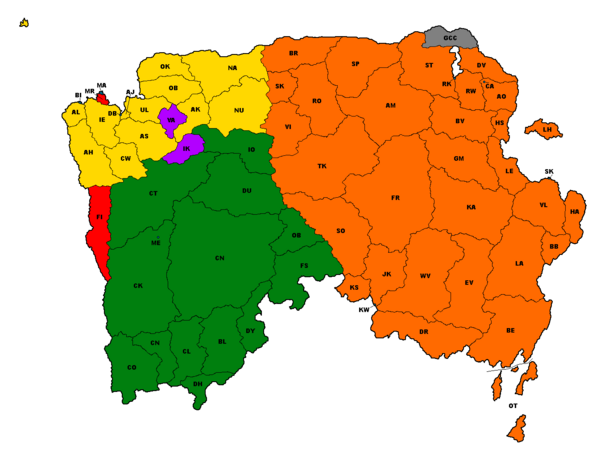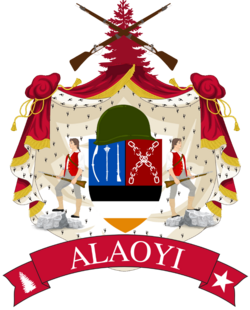Federal Entities of Alaoyi: Difference between revisions
No edit summary |
No edit summary |
||
| Line 36: | Line 36: | ||
According the Alaoyian Constitution, the [[Alaoyi|Federative Republic]] consists of 29 [[Provinces of Alaoyi|provinces]], 13 [[Counties of Alaoyi|counties]], 12 [[Districts of Alaoyi|districts]], eight [[Federal Cities of Alaoyi|federal cities]], two [[Autonomous Republics of Alaoyi|autonomous republics]], two [[Autonomous Communities of Alaoyi|autonomous communities]], and a [[Greater Cetanni Commonwealth|single]] [[National Commonwealth (Alaoyi)|national commonwealth]], all of which have differing levels of autonomy within their own borders. Autonomous communities, despite being autonomous within their own borders, are only entited to a single representative on the [[Alaoyian National Council|National Council]] and are not considered separate in terms of [[Alaoyian Senate|Senatorial representation]]. According to the Alaoyian Constitution, it is forbidden for the Parliament to redraw the borders of any entity, and any special autonomous divisions can only have their status changed with a two thirds vote. | According the Alaoyian Constitution, the [[Alaoyi|Federative Republic]] consists of 29 [[Provinces of Alaoyi|provinces]], 13 [[Counties of Alaoyi|counties]], 12 [[Districts of Alaoyi|districts]], eight [[Federal Cities of Alaoyi|federal cities]], two [[Autonomous Republics of Alaoyi|autonomous republics]], two [[Autonomous Communities of Alaoyi|autonomous communities]], and a [[Greater Cetanni Commonwealth|single]] [[National Commonwealth (Alaoyi)|national commonwealth]], all of which have differing levels of autonomy within their own borders. Autonomous communities, despite being autonomous within their own borders, are only entited to a single representative on the [[Alaoyian National Council|National Council]] and are not considered separate in terms of [[Alaoyian Senate|Senatorial representation]]. According to the Alaoyian Constitution, it is forbidden for the Parliament to redraw the borders of any entity, and any special autonomous divisions can only have their status changed with a two thirds vote. | ||
Every federal | Every federal entity has its own head, a parliament, and court system. Each federal entity has its own constitution or charter and legislation, although the authority of these organs differ. Entites have equal rights in relations with federal government bodies. The federal entities have equal representation—four delegates each—in the Federation Council, the upper house of the Parliament. They do, however, differ in the degree of autonomy they enjoy; republics are offered more autonomy. | ||
=Types= | |||
[[File:Alaoyi with Cities 2.png|center|600px|frameless]] | |||
{| class="wikitable sortable" | |||
|- | |||
! Federal Entities | |||
! Governance | |||
|- | |||
| {{legend|#FFEC77|29 [[Provinces of Alaoyi|Province]]s}} | |||
| The most common type of federal subject with a governor and locally elected legislature. Provinces tend to cover majority-Onslander areas. | |||
|- | |||
| {{legend|#00C160|13 [[Counties of Alaoyi|Counties]]}} | |||
| For all intents and purposes, counties are identical to provinces but in Diash-speaking areas. The title of "county" is historic, referring to the Diash royalty (counts) that ruled the area before being conquered by Alanna. | |||
|- | |||
| {{legend|#FF9400|12 [[Districts of Alaoyi|District]]s}} | |||
| For all intents and purposes, districts are identical to provinces and counties but in Ndibeanyan-speaking areas. The title of "district" comes from the subdivisions of Imperial Alanna and came over to what is now Alaoyi with the colonists. | |||
|- | |||
| {{legend|#006989|8 [[Federal Cities of Alaoyi|Federal Cities]]}} | |||
| Major cities that function as separate regions. | |||
|- | |||
| {{legend|#FF0037|2 [[Autonomous Republics of Alaoyi|Autonomous Republic]]s}} | |||
| Autonomous areas consisting of an ethnic minority, there are currently two; the Marchan and Inith Autonomous Republics. Each is considered to be legally independent nations, with their own government and legislature, that are represented by the Alaoyian government in international affairs, allow freedom of movement and commerce with Alaoyi, and are members of a currency union with Alaoyi. | |||
|- | |||
| {{legend|#C300FF|2 [[Autonomous Communities of Alaoyi|Autonomous Communities]]}} | |||
| The only autonomous communities are the Ikhetese and Vanhish. Autonomous communities are technically parts of a districts but are given special rights and privileges that cannot be revoked by the district government. They are similar to autonomous republics, but have directorial council governments and are not legally independent. Autonomous communities are technically not granted representation on the national council, but one member of their district's delegation is appointed by the community government. | |||
|- | |||
| {{legend|#808080|1 [[National Commonwealths of Alaoyi|National Commonwealth]]}} | |||
| National commonwealths are technically full fledged federal entities on par with a province or province-equivalent, but not considered to be legally independent like an autonomous republic is. National commonwealths consist of a nationally-recognized minority group and are generally autonomous. There is only one national commonwealth, the Greater Cetan Commonwealth. | |||
|- | |||
|} | |||
=List= | |||
{{Alaoyi topics}} | {{Alaoyi topics}} | ||
{{Manala topics}} | {{Manala topics}} | ||
[[Category:Manala]] | [[Category:Manala]] | ||
[[Category: Alaoyi]] | [[Category: Alaoyi]] | ||
Revision as of 00:23, 23 February 2023
| Federal subjects 3 native names
| |||||||
|---|---|---|---|---|---|---|---|

| |||||||
| Category | Federal presidential constitutional republic | ||||||
| Location | |||||||
| Created | 1 January 1989 | ||||||
| Number | 67 | ||||||
| Populations | XXX-YYY | ||||||
| Government | Regional government, federal government | ||||||
| Subdivisions | Municipalities | ||||||
The federal entities of Alaoyi, also referred to as the first level divisions of Alaoyi, or simply as entities of the federative republic, are the main constituent entities of Alaoyi, the top-level political division below the national government, according to the Alaoyian Constitution. All Alaoyian federal entities are either contiguous or just offshore the mainland.
According the Alaoyian Constitution, the Federative Republic consists of 29 provinces, 13 counties, 12 districts, eight federal cities, two autonomous republics, two autonomous communities, and a single national commonwealth, all of which have differing levels of autonomy within their own borders. Autonomous communities, despite being autonomous within their own borders, are only entited to a single representative on the National Council and are not considered separate in terms of Senatorial representation. According to the Alaoyian Constitution, it is forbidden for the Parliament to redraw the borders of any entity, and any special autonomous divisions can only have their status changed with a two thirds vote.
Every federal entity has its own head, a parliament, and court system. Each federal entity has its own constitution or charter and legislation, although the authority of these organs differ. Entites have equal rights in relations with federal government bodies. The federal entities have equal representation—four delegates each—in the Federation Council, the upper house of the Parliament. They do, however, differ in the degree of autonomy they enjoy; republics are offered more autonomy.
Types
| Federal Entities | Governance |
|---|---|
29 Provinces
|
The most common type of federal subject with a governor and locally elected legislature. Provinces tend to cover majority-Onslander areas. |
13 Counties
|
For all intents and purposes, counties are identical to provinces but in Diash-speaking areas. The title of "county" is historic, referring to the Diash royalty (counts) that ruled the area before being conquered by Alanna. |
12 Districts
|
For all intents and purposes, districts are identical to provinces and counties but in Ndibeanyan-speaking areas. The title of "district" comes from the subdivisions of Imperial Alanna and came over to what is now Alaoyi with the colonists. |
| Major cities that function as separate regions. | |
| Autonomous areas consisting of an ethnic minority, there are currently two; the Marchan and Inith Autonomous Republics. Each is considered to be legally independent nations, with their own government and legislature, that are represented by the Alaoyian government in international affairs, allow freedom of movement and commerce with Alaoyi, and are members of a currency union with Alaoyi. | |
| The only autonomous communities are the Ikhetese and Vanhish. Autonomous communities are technically parts of a districts but are given special rights and privileges that cannot be revoked by the district government. They are similar to autonomous republics, but have directorial council governments and are not legally independent. Autonomous communities are technically not granted representation on the national council, but one member of their district's delegation is appointed by the community government. | |
| National commonwealths are technically full fledged federal entities on par with a province or province-equivalent, but not considered to be legally independent like an autonomous republic is. National commonwealths consist of a nationally-recognized minority group and are generally autonomous. There is only one national commonwealth, the Greater Cetan Commonwealth. |

